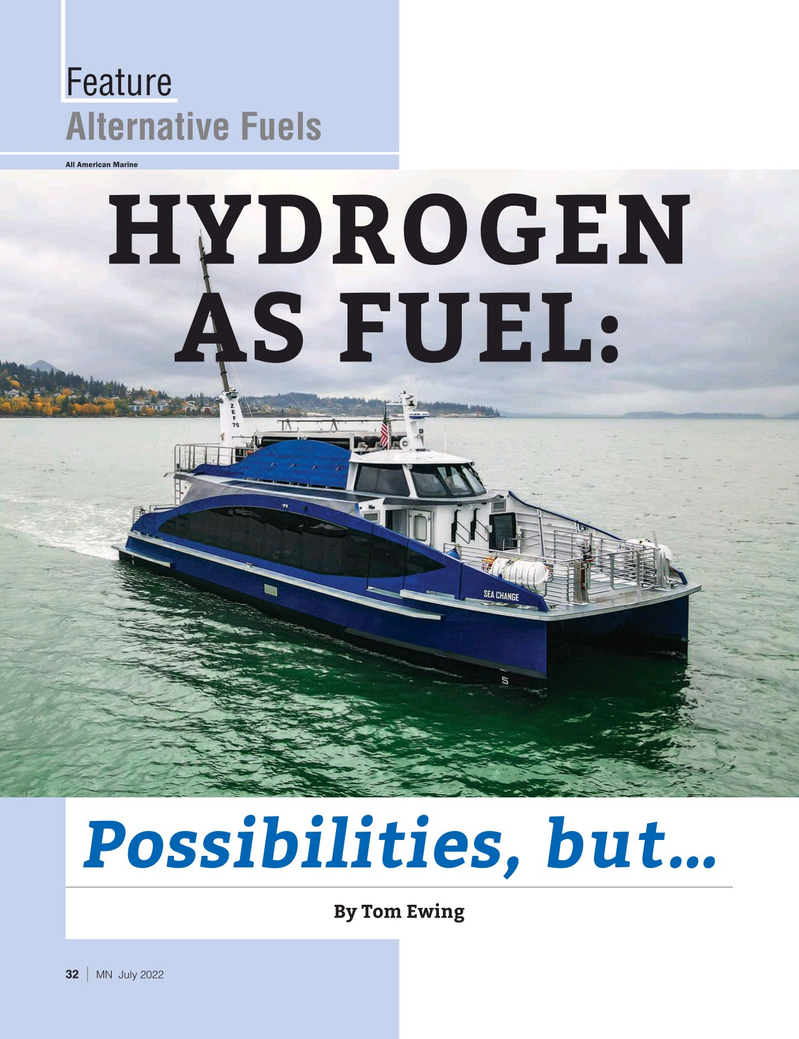
Page 32: of Marine News Magazine (July 2022)
Propulsion Technology
Read this page in Pdf, Flash or Html5 edition of July 2022 Marine News Magazine
Feature
Alternative Fuels ydrogen is everywhere. You know that from match with the very foundations of chemistry and phys- high school chemistry. And you also know it ics—and economics.
from Marine News’ almost daily updates about Regulators, not to mention a concerned citizenry, will
H powered vessel projects around the world. need to take a deep breath about proposals to transport
H
As a fuel that could potentially replace fossil fuels, H is and store hydrogen. Maybe production could be kept in the spotlight. Perhaps the brightest spotlight, at least in remote, but at some point, a fuel has to move to where the U.S., is within the Department of Energy’s “Energy it’s needed: ports, holding tanks, rail yards, transfer ves-
Earthshots” initiative. sels, truck depots, airports. Acceptable risk will be dif-
R&D on H was the ? rst such Earthshot announced last ? cult to document.
year. DOE wants the “Hydrogen Shot” program to “accel- erate innovations and spur demand of clean hydrogen by Some lessons learned reducing the cost by 80%.” Reports about new H projects are important, of course,
Note the reference to “clean” hydrogen. Currently, U.S. but there are also quite a few H projects that have conclud- industry produces several million cubic feet of H daily, ed. Do the lessons from those projects con? rm the kind used for industrial applications such as re? ning, treating of expectant promise inherent in a national initiative like metals and food processing. H is produced using high- Hydrogen Shot? Here’s a closer look at two such H projects temperature steam (“steam reforming”) and via electroly- with a maritime focus.
sis – splitting water into H and oxygen. Each process is energy intensive and expensive, usually fueled by natural Sandia National Lab’s Fuel Cell Generator gas. The conundrum has always been: why use H as fuel In 2017, Sandia National Laboratories, part of DOE’s when natural gas is so cheap? The carbon factor forces a network of energy R&D labs, completed a Maritime Fuel different perspective. If clean H could be generated using Cell Generator Project in Hawaii. This ? rst-of-its kind hy- renewable energy, there could result an almost limitless drogen fuel cell (FC) generator was built by Hydrogenics, supply of a fuel that, according to many experts, shares a company now owned by Cummins, Inc. Young Brothers, characteristics with natural gas, making H a relatively fa- the Hawaiian shipping company, agreed to use the genera- miliar replacement.
Hydrogen Shot seeks to reduce the cost of clean hydro- gen by 80% to $1 per 1 kilogram in 1 decade (“1 1 1”).
To get traction on this, in February, DOE published a re- quest for information on “clean hydrogen manufacturing, recycling and electrolysis technology research, develop- ment and demonstration (RD&D)” and a second request pertaining to establishing a number of R&D “Hydrogen
Hubs” at various research facilities in the US. One goal is to locate the R&D Hubs in the same city or region as new H production. Then, R&D and production could work together to get H mainstreamed even faster.
The optimism about H, of course, has to be tempered with dif? cult realities, very dif? cult realities. Hydrogen is volatile, highly ? ammable and explosive. It’s expensive to produce. Storage and transport are dif? cult, requir- ing even more energy to compress the gas into a liquid and then store it at low temperatures. Trying to overcome these challenges involves a mental and physical wrestling
U.S. Department of Energy www.marinelink.com MN 33|

 31
31

 33
33
